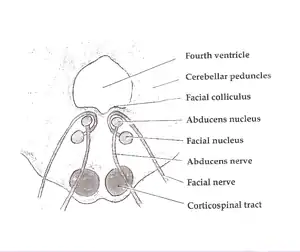Lateral pontine syndrome
| Lateral pontine syndrome | |
|---|---|
 | |
| Pons | |
| Specialty | Neurology |
A lateral pontine syndrome is a lesion which is similar to the lateral medullary syndrome, but because it occurs in the pons, it also involves the cranial nerve nuclei of the pons.
Symptoms
Damage to the following areas produces symptoms (from medial to lateral):
| Structure affected | Effect |
|---|---|
| Lateral spinothalamic tract | Contralateral loss of pain and temperature from the trunk and extremities. |
| Facial nucleus & facial Nerve (CN.VII) | (1) Ipsilateral paralysis of the upper and lower face (lower motor neuron lesion). (2) Ipsilateral loss of lacrimation and reduced salivation. (3) Ipsilateral loss of taste from the anterior two-thirds of the tongue. (4) Loss of corneal reflex (efferent limb). |
| Principal sensory trigeminal nucleus and tract | Ipsilateral loss of all sensory modalities to the face (facial hemianesthesia) |
| Vestibular Nuclei and intraaxial nerve fibers | Nystagmus, nausea, vomiting, and vertigo |
| Cochlear nuclei and intraaxial nerve fibers | Hearing loss - ipsilateral central deafness |
| Middle & inferior cerebellar peduncle | Ipsilateral limb and gait ataxia |
| Descending sympathetic tract | Ipsilateral Horner's syndrome (ptosis, miosis, & anhydrosis) |
Causes
It can be caused by an interruption to the blood supply of the anterior inferior cerebellar artery or circumferential arteries.[1]
Treatment
References
- ↑ Campbell, William W. (2012). DeJong's The Neurologic Examination. Lippincott, Williams & Wilkins. p. 338. ISBN 9781469817521.
External links
This article is issued from Offline. The text is licensed under Creative Commons - Attribution - Sharealike. Additional terms may apply for the media files.